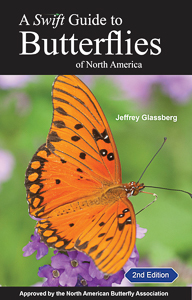 |
by Jeffrey Glassberg
Published by Princeton
Softback, 420 pages, ISBN: 978-0-691-17650-5
From the publisher: "This is a revised second edition of the most detailed, comprehensive, and user-friendly photographic field guide to the butterflies of North America. Written by Jeffrey Glassberg, the pioneering authority on the field identification of butterflies, the guide covers all known species, beautifully illustrating them with 3,500 large, gorgeous color photographs—the very best images available. This second edition includes more than 500 new photos and updated text, maps, and species names. For most species, there are photographs of topsides and undersides, males and females, and variants. All text is embedded in the photographs, allowing swift access in the field, and arrows point to field marks, showing you exactly what to look for. Detailed, same-page range maps include information about the number of broods in each area and where strays have been recorded. Color text boxes highlight information about habitat, caterpillar food plants, abundance and flight period, and other interesting facts. Also included are a quick visual index and a caterpillar food plant index. The result is an ideal field guide that will enable you to identify almost every butterfly you see.
Jeffrey Glassberg is a leading butterfly authority and author. He is president of the North American Butterfly Association, editor of American Butterflies magazine, and the author of many books, including the Butterflies through Binoculars series. He is adjunct professor of evolutionary biology at Rice University and lives in Morristown, New Jersey".
This is the second edition of the highly acclaimed photographic field guide that first appeared in 2012. It includes revised text, maps and nomenclature, as well as some 500 new photos, making it for the time being the most complete and up-to-date identification guide to the butterflies of North America.
As the author points out in his introduction, the book is entirely focused on the identification of adult butterflies. Only such ecological and biological information as furthers this purpose is given. To be fair, that actually represents quite a lot, including for all species concise details of the foodplant, phenology, habitat and distribution in North America, and for some, where diagnostic, behavioural observations too. Nevertheless, the absence of any anecdotal or discursive accounts of the butterflies, or even, in most cases, an indication of their relative abundance, makes the species accounts a little one-dimensional. The test, therefore, is whether the book succeeds in its primary purpose, of enabling the accurate identification of North American butterflies.
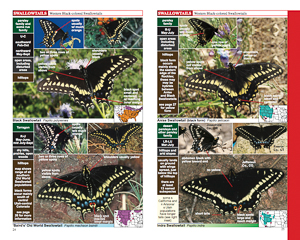 | 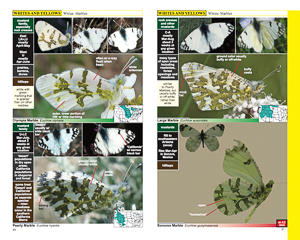 |
I am happy to say it does, thanks to the outstanding photographs and obvious expertise of the author. Every species is illustrated with several - in some cases many - pictures, covering the full range of forms likely to be seen. Because almost all illustrations are photographs of living butterflies (a very small number of set specimens are included) these also show how the species will actually look in the wild. The pictures are copiously annotated to draw attention to salient features, saving text-space and avoiding ambiguity for beginners. Living in Europe, I could not test-drive the book in the field, so I invited a friend, recently returned from the States, to send me some unlabelled photos of difficult species. Without exception, I was able to identify them and felt confident with my diagnoses. They included several potentially confusing skippers but in each case I was able to pinpoint critical features confirming the identification.
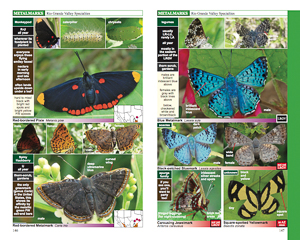 | 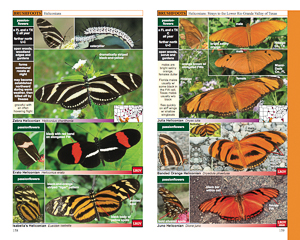 |
For the complete beginner, the book includes a visual index - a generous and intelligent selection of small photos pointing the reader to the pages where similar species are illustrated. This is a very useful feature, given the huge number of species found in North America. I tested it with a few randomly chosen species I have seen in the States, to see if the nearest image really did take me to the right part of the book. In every case it did.
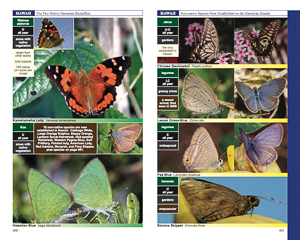 |
What reservations I do have are not really specific to this book but more a comment on photo-guides in general. Despite the obvious strengths of the format - not least the pleasure of admiring pictures of living creatures - there is altogether too much visual information, not all of it relevant and some potentially misleading.
Differing light conditions or angles of view can make similar species look different in arbitrary ways, and size comparisons are difficult when the tiniest butterflies are blown up to fill the same space as the giants. The annotations help enormously here, drawing the reader's eye to what really matters, but I still find standardised, life-size illustrations on a plain background - preferably paintings - easier to browse and more useful for homing in swiftly on a butterfly's identity.
Those reservations aside, and accepting the narrow focus on identification, I think this is about as good a photo-guide as it is possible to get. Every square millimetre of every page is crammed full of precisely targeted information, expressly designed to make sure you can name that butterfly. For this reason - as well as the very reasonable price - I have no difficulty in recommending the book to anyone interested in the butterflies of North America. Even if you already have one of the other guides, such as Kaufman (1), Peterson (2) or the now dated but outstanding Scott (3), it is worth adding this volume to your library as an additional and complementary resource.
The book is available through all good book stores, including those that are online.